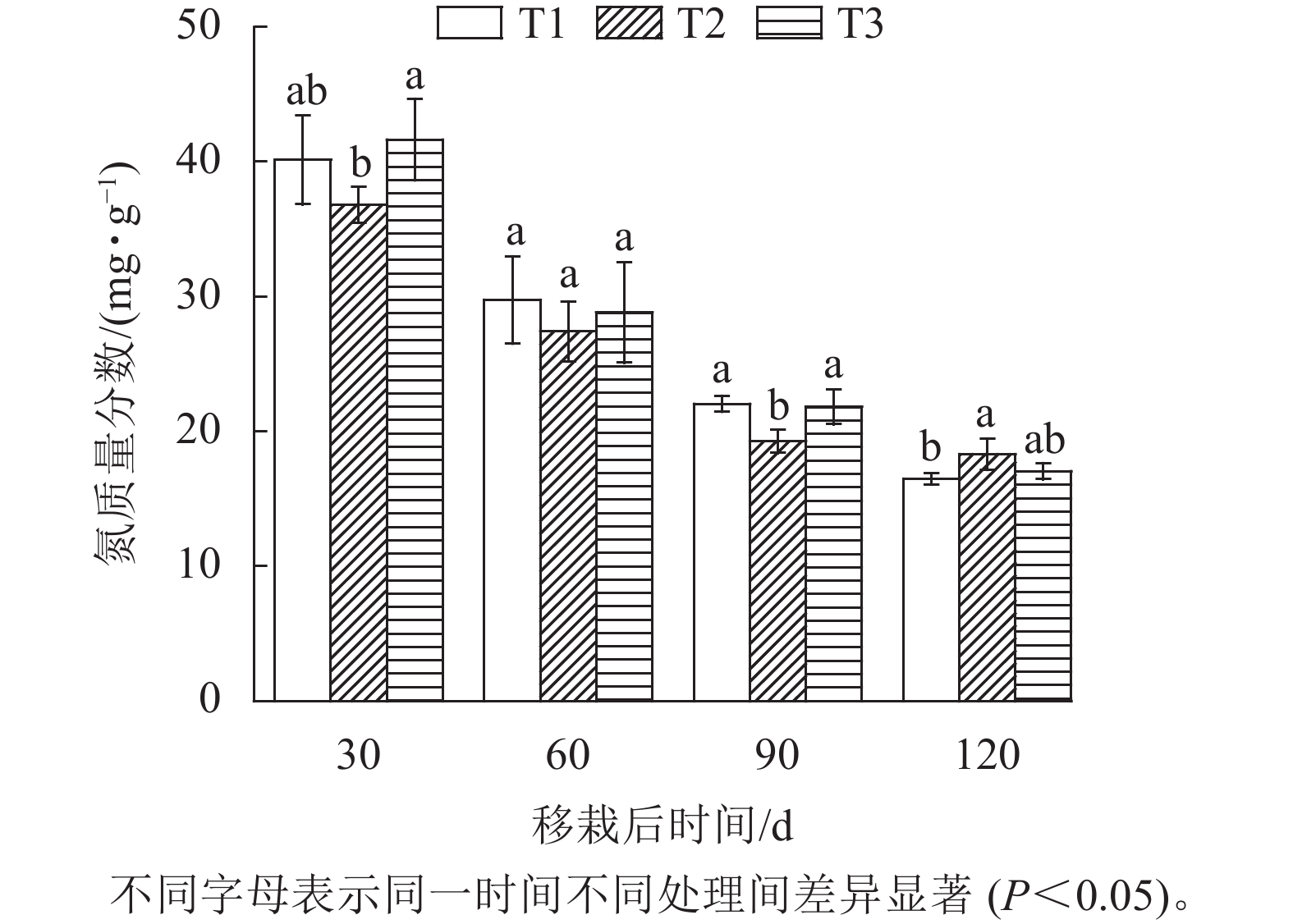-
生物质炭基肥是一种以生物质炭为基质,根据不同区域土地特点、不同作物生长特点以及科学施肥原理,添加有机质或无机质配制而成的生态环保型肥料。生物质炭具有微观孔隙结构、较大的比表面积和高吸附性等特点,这使得生物质炭基肥在优化土壤理化性质和调节土壤微生物群落及数量等方面效果显著[1]。研究表明:施用生物质炭基肥可以显著改善土壤的物理性状[2],降低土壤容重[3],增加田间持水量和透气性[4],提高土壤pH和养分有效性[5]。在生产实践中,施用生物质炭基肥可实现化肥减施,提高当地烟农收益的目的[6−7]。根据不同用途,研究人员相继开发出多种生物质炭基肥类型,并已在北方壤土、砂土麦田和南方烟田进行应用[8]。
尽管生物质炭基肥在烤烟Nicotiana tabacum种植中已经得到一定的推广,但相关研究多集中在施用生物质炭基肥对烤烟地上部生长及养分积累方面[9−10],而对烤烟根系发育及其与烤后烟化学品质关系的研究鲜有报道。重庆植烟区烟叶品质和地方性香韵特色突出,是中国烟叶的重要产区。近年来,随着有机肥的使用比例过少和土壤连作效应的增加,重庆植烟区土壤有效养分严重失衡,土壤酸化、黏化、贫瘠以及微生物群落结构恶化已经成为丞待解决的问题[11]。研究显示:重庆植烟土壤在2005年已经出现了严重的酸化现象[12],有一半以上的土壤严重酸化,其中黔江县、丰都县的酸化土壤面积均达65%以上[13],酸碱度适宜的土壤不到35%。因此,在生产中应采取增施生物质炭基肥、种植绿肥等措施加强对酸化土壤的治理,为优质烟叶的生产提供保障。本研究选用‘云烟116’N. tabacum ‘Yunyan 116’为材料,在重庆彭水县设置常规施肥、生物质炭基有机肥和生物质炭基复混肥大田试验,研究生物质炭基肥对烤烟根系发育、产量产值和化学品质的影响,以期为指导当地烤烟生产和提高烟农收益提供理论依据和技术支持。
-
于2020年和2021年3—10月,在重庆市彭水县润溪镇重庆烟草科学研究所彭水试验站(29.14°N,107.96°E)开展研究。烟草种植制度为1年1熟,冬季休闲。该区属亚热带湿润季风气候,年均气温为17.5 ℃,年均降水量为1 241.0 mm。土壤类型为黄壤土,pH 5.4,有机质和有机碳质量分数分别为24.1和14.0 g·kg−1,碱解氮、速效磷、速效钾质量分数分别为88.8、12.8、147.8 mg·kg−1。
-
大田试验选择肥力中等、地势平坦、无严重病害史的田块,采取完全随机设计,共设3个处理:①常规施肥(T1)。按照当地农户习惯,施农家肥2 250 kg·hm−2和烟草复合肥750 kg·hm−2;②生物质炭基有机肥(T2)。在T1处理基础上增施生物质炭基有机肥1 350 kg·hm−2;③生物质炭基复混肥(T3)。在农家肥2 250 kg·hm−2的基础上增施生物质炭基复混肥750 kg·hm−2。其中T1和T2处理中的烟草复合肥氮磷钾质量比为6∶12∶25,生物质炭基复混肥中的氮磷钾和生物质炭的质量比为8∶10∶20∶18,生物质炭基有机肥发酵原料含质量分数为85%的杏鲍菇渣和15%的生物质炭。各处理分别用尿素、过磷酸钙和硫酸钾补充配平,保证各处理氮磷钾肥用量相同。每个处理重复3次,共9个小区。生物质炭基有机肥和生物质炭基复混肥均由贵州金叶丰农业科技有限公司提供。供试品种为‘云烟116’,由重庆市烟草公司彭水县分公司提供。烟苗采用漂浮育苗,于5月上旬移栽,移栽密度为16 492 株·hm−2,移栽行距为120 cm,株距为50 cm,垄高为40 cm。其他田间管理按照规范化栽培技术进行。
-
分别在移栽后的30、60、90和120 d,选取每个处理具有代表性的烤烟3株,取烟株根系20 g在超低温冰箱−80 ℃内保存,用于测定生理指标,余下部分,在105 ℃下杀青15 min,65 ℃烘干至恒量后用粉碎机进行粉碎,过60目筛,装入封口袋保存,用于测定根系氮钾和烟碱质量分数。
-
将移栽后120 d的烟叶从下部叶自下而上进行采收,采收后按照小区进行统一编杆烘烤。依据GB 2635—92对烘烤后的烟叶样品进行分级,每处理分别取上部叶、中部叶和下部叶烟叶各2.5 kg,置于65 ℃烘箱烘至恒量,粉碎过60目筛,用于测定烤后烟叶的化学成分。
-
根系活力采用改良氯化三苯基四氮唑法测定[14];根系氮质量分数采用凯氏定氮法测定,根系钾质量分数采用火焰光度计法测定,根系烟碱质量分数采用提取脱色法测定[15]。
-
各处理小区烟叶单独采收编杆,单独计产量。待烟叶全部采收烘烤完毕后,依照GB 2635—1992对烤后烟叶进行分级,计算产值、产量与上等烟比例。
-
分别测定分析各处理烤后烟叶的常规化学成分(质量分数)[16]。全氮采用凯氏定氮法测定;总糖和还原糖采用3,5-二硝基水杨酸(DNS)比色法测定;烟碱采用提取脱色法测定;氯离子采用浸提法(热蒸馏水法)测定;全钾采用火焰光度计法测定。
-
使用Excel整理数据,采用SPSS 22.0对烤烟的根系活力、根条数、根系氮、钾和烟碱质量分数以及烤后烟的经济性状和化学品质等进行多重比较和相关分析,其中多重比较采用Duncan的SSR检验法(显著性水平为0.05),相关分析采用Pearson相关系数中的双尾检验,采用Origin 2021绘图。
-
由图1可知:随着烟株移栽时间的延长,3个处理的根系活力均呈先上升后下降的抛物线式变化,以移栽后60 d时最高,移栽后120 d时最低。在移栽后30 d时,3个处理的烟株根系活力无显著差异。在移栽后60 d时,T2处理的根系活力较T1处理显著提高(P<0.05)。在移栽后90 d时,T2与T3处理的根系活力无显著差异,但较T1处理分别显著提高了46.8%和34.4%(P<0.05)。在移栽后120 d时,T2处理的根系活力与T3和T1处理差异显著(P<0.05)。生物质炭基肥可以提高烟株根系活力,总体上以T2处理效果最好。
-
如表1所示:烟株的侧根条数在移栽后的30 d时,3个处理间无显著性差异。在移栽后60 d时,T2和T3处理的侧根条数显著高于T1处理(P<0.05)。在移栽后90 d时,3个处理侧根条数从大到小依次为T3、T2、T1,T3处理相比T1处理增加了17.5% (P<0.05)。在移栽后120 d时,T2和T3处理比T1处理提高14.7%和26.4% (P<0.05)。
移栽后时间/d 处理 侧根/条 不定根/条 30 T1 13.8±4.1 a 62.4±1.3 b T2 14.3±1.2 a 74.9±2.6 a T3 15.4±0.8 a 76.6±3.1 a 60 T1 17.5±1.4 b 89.2±1.5 c T2 22.7±2.9 a 117.2±1.9 b T3 24.7±1.6 a 136.6±2.0 a 90 T1 25.7±3.8 b 59.0±4.8 c T2 26.3±1.0 ab 68.6±0.5 b T3 30.2±2.4 a 75.0±3.3 a 120 T1 23.1±1.3 b 44.8±0.8 b T2 26.5±1.6 a 54.7±1.5 a T3 29.2±1.7 a 53.3±1.9 a 说明:不同字母表示同时间不同处理间差异显著(P<0.05)。 Table 1. Change of root number of flue-cured tobacco under different biochar-based fertilizers after transplantation
移栽后30 d时,T2和T3处理烟株的不定根条数均高于T1处理,且与T1处理呈显著差异(P<0.05)。移栽后60和90 d时,3个处理的不定根条数从大到小依次为T3、T2、T1,且3个处理间均存在显著差异(P<0.05)。移栽后120 d时,以T2处理的不定根条数最多,其次为T3处理,最后为T1处理,且T2、T3与T1处理差异达显著水平(P<0.05)。总体上,烟株的侧根条数和不定根条数以T3处理最多。
-
由图2可以看出:3个处理根系钾质量分数随烟株的生长呈逐渐下降趋势。移栽后30和60 d时,T2和T3处理的烟株根系钾质量分数均高于T1处理,其中T3处理显著高于T1处理(P<0.05)。移栽后90和120 d时,3个处理的烟株根系钾质量分数无显著差异。
从图3可见:在移栽后的30~90 d,T3和T1处理的烟株根系氮质量分数均高于T2处理。其中在移栽后30 d时,T3与T2处理烟株根系氮质量分数差异显著(P<0.05),在移栽后60 d时,3个处理之间的根系氮质量分数差异不显著。在移栽后90 d时,T1和T3处理根系氮质量分数均显著高于T2处理(P<0.05),而在移栽后120 d时,T2处理根系氮质量分数最高,且与T1处理差异显著(P<0.05)。
图4表明:3个处理的烟碱质量分数均在移栽后90 d时达最高值。移栽后30 d时,3个处理的根系烟碱质量分数无显著差异。移栽后60 d时,以T3处理烟株根系的烟碱质量分数最高,且显著高于T1与T2处理(P<0.05)。移栽后90 d时,仍以T3处理最高,且与T2处理间差异显著(P<0.05)。移栽后120 d时,T1和T3处理降幅较大,以T2处理烟碱质量分数最高,且与T1处理间差异显著(P<0.05)。
-
从表2可见:T2处理的烟叶产量最高,比T1处理高16.9% (P<0.05)。T3与T1处理差异不显著,但比T1处理增加了11.4%。3个处理的产值与产量从大到小依次为T2、T3、T1。3个处理间的均价差异不显著(P>0.05),其中T2和T3处理的均价高于T1处理。各处理间的上中等烟比例差异显著(P<0.05),其中以T2处理最高,其次为T3处理,最后为T1处理。总体上,与T1处理相比,T2和T3处理的产量、产值、均价和中上等烟比例均呈增加趋势,整体以T2处理效果最佳,说明施用生物质炭基肥对烤后烟的产量产值及上中等烟比例均有明显的促进作用。
处理 产量/
(kg·hm−2)产值/
(万元·hm−2)均价/
(元·kg−1)上中等烟
比例/%T1 1 933 b 5.3 b 27.4 a 83.1 c T2 2 260 a 6.5 a 28.5 a 86.0 a T3 2 153 ab 6.0 ab 28.0 a 84.6 b 说明:同列不同字母表示差异显著(P<0.05)。 Table 2. Comparison of economic traits of different biochar-based fertilizer treatments
-
烟叶内在化学成分及其协调性是衡量烤烟品质的重要指标[17]。由表3可知:T2处理烤后烟上部叶中的氯离子、还原糖、烟碱质量分数最高,且糖碱比高于其他2个处理。但T3处理的烤后烟叶的钾和总氮质量分数较为突出,在3个处理中钾氯比和氮碱比最高。T1处理的总糖质量分数占比最高,与T2、T3处理差异显著(P<0.05)。T2处理烤后烟中部叶的氯离子、还原糖、总糖和烟碱质量分数仍然最高,其中,3个处理的上部叶和中部叶的氯离子质量分数均差异显著(P<0.05),且T2和T3处理的还原糖质量分数均差异显著(P<0.05)。T3处理的钾和总氮质量分数最高,与T1处理差异显著(P<0.05),T3处理的钾氯比和氮碱比最高,与其他2个处理差异显著(P<0.05),糖碱比则以T1处理最高。烤后烟下部叶中3个处理的氯离子、烟碱和总氮质量分数及钾氯比差别不显著,但钾、还原糖和总糖质量分数均以T2处理最高,且与T1或T3处理差异显著(P<0.05),氮碱比则以T1处理最高。
等级 处理 氯/% 钾/% 钾氯比 还原糖/% 总糖/% 烟碱/% 糖碱比 总氮/% 氮碱比 上部叶 T1 0.24 c 1.51 b 6.43 b 19.82 ab 27.35 a 2.44 a 8.12 a 2.73 a 1.07 a T2 0.28 a 1.51 b 5.41 c 20.73 a 25.61 b 2.55 a 8.13 a 2.57 b 0.97 b T3 0.26 b 1.90 a 7.32 a 17.74 b 23.17 c 2.61 a 6.80 b 2.89 a 1.11 a 中部叶 T1 0.35 c 1.65 b 4.75 b 21.84 a 28.01 a 2.18 b 10.02 a 2.31 b 0.93 b T2 0.40 a 1.70 b 4.23 b 22.39 a 28.64 a 2.56 a 8.75 b 2.46 ab 0.96 b T3 0.37 b 2.09 a 5.63 a 20.58 b 27.66 a 2.17 b 9.48 ab 2.74 a 1.11 a 下部叶 T1 0.31 a 1.91 b 6.12 a 20.87 b 31.21 ab 1.86 a 11.22 b 2.15 a 0.92 a T2 0.33 a 2.53 a 7.57 a 24.66 a 32.43 a 1.89 a 13.05 a 2.02 a 0.87 b T3 0.34 a 2.18 b 6.53 a 21.39 b 28.89 b 1.93 a 11.08 b 2.10 a 0.87 b 说明:不同字母表示同等级不同处理间差异显著(P<0.05);氯、钾、还原糖、总糖、烟碱、总氮均为质量分数。 Table 3. Comparison of chemical composition of flue-cured tobacco
-
相关分析(表4)可知:移栽后30 d时,根系钾与烟叶氯离子呈显著正相关(P<0.05);移栽后60 d时,烟叶钾与根系活力呈显著正相关(P<0.05),与氮碱比呈显著负相关(P<0.05),根系氮与烟叶总氮呈显著正相关(P<0.05),但与烟叶钾呈显著负相关(P<0.05);移栽后90 d时,根系烟碱与烟叶总氮呈显著负相关(P<0.05),与烟叶钾氯比呈显著正相关(P<0.05),而根系氮与烟叶还原糖呈显著负相关(P<0.05);移栽后120 d时,根系烟碱与烟叶钾呈显著正相关(P<0.05)。根系钾与烟叶总糖呈显著正相关(P<0.05),根系氮与烟叶钾氯比呈极显著正相关(P<0.01)。
移栽后时间/d 根系性状 烟叶化学成分 还原糖 总糖 总氮 钾 烟碱 糖碱比 氮碱比 钾氯比 氯离子 30 根系活力 0.395 −0.410 −0.621 0.665 0.936 0.213 0.970 0.528 0.996 烟碱 −0.835 −0.970 0.663 −0.618 0.512 −0.924 0.068 −0.743 0.262 钾 0.252 −0.543 −0.496 0.545 0.978 0.064 −0.923 0.394 0.998* 氮 −0.899 −0.930 0.754 −0.714 0.397 0.966 0.196 −0.823 0.135 60 根系活力 0.919 0.332 −0.99 0.997* 0.434 0.828 −0.870 0.968 0.660 烟碱 −0.075 −0.785 −0.188 0.245 0.993 −0.263 −0.748 0.076 0.924 钾 0.573 −0.216 −0.767 0.803 0.844 0.407 −0.999* 0.690 0.957 氮 −0.955 −0.428 0.999* −0.999* 0.339 −0.882 0.814 −0.989 −0.579 90 根系活力 0.789 0.081 −0.922 0.943 0.649 0.658 −0.967 0.872 0.830 烟碱 0.976 0.499 −0.999* 0.995 0.262 0.917 −0.765 0.998* 0.512 钾 −0.858 −0.201 0.962 −0.976 −0.552 −0.745 0.929 −0.925 −0.756 氮 −0.999* −0.698 0.957 −0.939 −0.015 −0.987 0.582 −0.984 −0.284 120 根系活力 0.958 0.860 −0.849 0.817 −0.245 0.995 −0.350 0.903 0.024 烟碱 0.922 0.339 −0.991 0.997* 0.427 0.832 −0.866 0.970 0.655 钾 0.616 0.997* −0.389 0.335 −0.759 0.754 0.254 0.491 −0.556 氮 0.989 0.562 −0.993 0.984 0.189 0.944 −0.715 0.999** 0.446 说明:*表示P<0.05;**表示P<0.01。 Table 4. Correlation analysis of flue-cured tobacco root traits and chemical properties
综合来看,根系性状与化学品质之间在移栽后存在不同的相关关系,且在移栽后60、90和120 d时更为突出,根系钾和氮与烤后烟的化学品质指标相关性均达到显著水平(P<0.05)。在移栽后90和120 d时,根系烟碱与化学品质指标相关性同样也达到显著水平(P<0.05)。
-
根系不仅是作物吸收水分和养分的重要器官,也是激素、氨基酸和有机酸等生物大分子的合成器官,其形态建成和生理功能将直接影响作物地上部分的生长发育、产量和品质[18]。不仅如此,对于烤烟来说烟株根系还是次生代谢产物烟碱的重要合成器官,其生长发育状况对烤烟品质有直接影响。在烤烟的生产实践中,烟株的主根长度、须根条数、根总体积和根尖数等根系形态指标与烤烟农艺性状表现出显著正相关[19]。本研究表明:T2和T3处理烟株的根系活力相比常规施肥均有所提升,其中T2处理的根系活力最高,这与韩毅等[20]的研究结果一致;另外,也有研究表明:添加生物质炭可以有效提高烟株的根系活力[21]。这说明生物质炭和生物质炭基肥本身具有的多孔和大比表面积结构有利于土壤通气性的增加,这对烟株根系活力的提高起到重要的调控作用。与此同时,施用生物质炭基肥能够显著增加烟株的不定根条数与侧根条数,这表明生物质炭基肥能够对烟株根系发育提供良好的生态环境[22−23]。根系钾和总氮质量分数均随着烟株的生长而逐渐降低,生物质炭基肥处理相比T1处理的降幅较小,可能是生物质炭具有缓释氮肥的作用,从而保证了烤烟各生长期所需的氮肥量,但要注意与氮肥的配施比例[24]。根系烟碱质量分数则在移栽后90 d达到峰值,可能与打顶后烟株体内的激素平衡状态被破坏有关,这与范江等[25]的研究结果一致。烟株的根系生长受到刺激,其生物量显著高于未打顶的烟株,发达的根系可促进烟株对养分的吸收。根系是合成烟碱的主要部位,打顶后烟株合成烟碱的能力大幅提升,进而提高烟株的烟碱积累量[26]。除了能够改善土壤的通透性之外,生物质炭基肥还含有丰富的大量元素与微量元素,从而为烟株根系的生长发育、后期烤烟产量和品质提供了保障[27]。
生物质炭基肥对常见农作物的生长具有促进作用,可达到增产的目的[28]。本研究结果表明:施用生物质炭基肥显著增加了烤烟产量、产值、均价和上中等烟比例,其中以施用生物质炭基有机肥处理烟株的产量、产值最佳。王晓强等[29]研究表明:生物质炭基肥与氮肥配施可提高烟叶产量和中上等烟比例,从而提高烟叶的均价及产值。同时施用生物质炭基肥可减少氮素化肥的施用量,从而改善烟叶内在化学成分的协调性,增加中性致香物质[30]。从不同生物质炭基肥对烤后烟常规化学成分的影响来看,T2和T3处理对烤烟内在常规化学成分有显著的影响。其中T2处理能显著提高上中下部叶的还原糖质量分数及中下部叶的总糖质量分数,这与李青山等[31]的研究结果一致。上中部叶的氯质量分数高于其他处理,减低总氮和烟碱质量分数处于适中稳定的范围,从而提高糖碱比。糖碱比高,有助于提高烟叶的安全性,柔和烟气。中上部叶钾质量分数差异不明显,钾氯比变化不大;T3处理可提高上中部叶的钾质量分数、钾氯比、氮碱比和总氮质量分数,T3处理的全氮、烟碱质量分数较高,可能由于施用生物质炭基复混肥可减少土壤养分的淋溶损失有关。T3处理的氯离子质量分数高,可能与淋溶损失能力与生物质炭基复合肥的施用成正比有关。据烟叶采收后对中部烟叶化学成分的分析表明:T2和T3处理烟叶在各指标上都符合优质烟叶的标准,T1处理在优质烟叶协调性方面略差。这表明施用生物质炭基肥不但能够促进烤烟生长,而且能提高烟叶内在化学成分的协调性,改善烟叶品质。
-
施用生物质炭基肥能促进烤烟根系发育,有效提升烟株的根系活力,增加侧根和不定根条数,延缓根系钾、氮质量分数流失,提高烟株根系的烟碱积累量。同时,施用生物质炭基肥可增加烤烟的产量产值,提升烤后烟的化学品质。本研究的生物质炭基有机肥更有利于促进烤烟根系的生长发育,改善烤后烟叶化学成分质量分数,提高烤烟产量、产值、均价和中上等烟比例。
Effect of biochar-based fertilizer on root development, yield and quality of flue-cured tobacco in Chongqing tobacco growing area
doi: 10.11833/j.issn.2095-0756.20230161
- Received Date: 2023-02-19
- Accepted Date: 2023-05-15
- Rev Recd Date: 2023-05-06
- Available Online: 2023-11-23
- Publish Date: 2023-11-23
-
Key words:
- biochar-based fertilizer /
- flue-cured tobacco /
- root system /
- yield /
- quality
Abstract:
| Citation: | SONG Peng, LI Hui, JIANG Houlong, et al. Effect of biochar-based fertilizer on root development, yield and quality of flue-cured tobacco in Chongqing tobacco growing area[J]. Journal of Zhejiang A&F University, 2023, 40(6): 1232-1240. DOI: 10.11833/j.issn.2095-0756.20230161 |




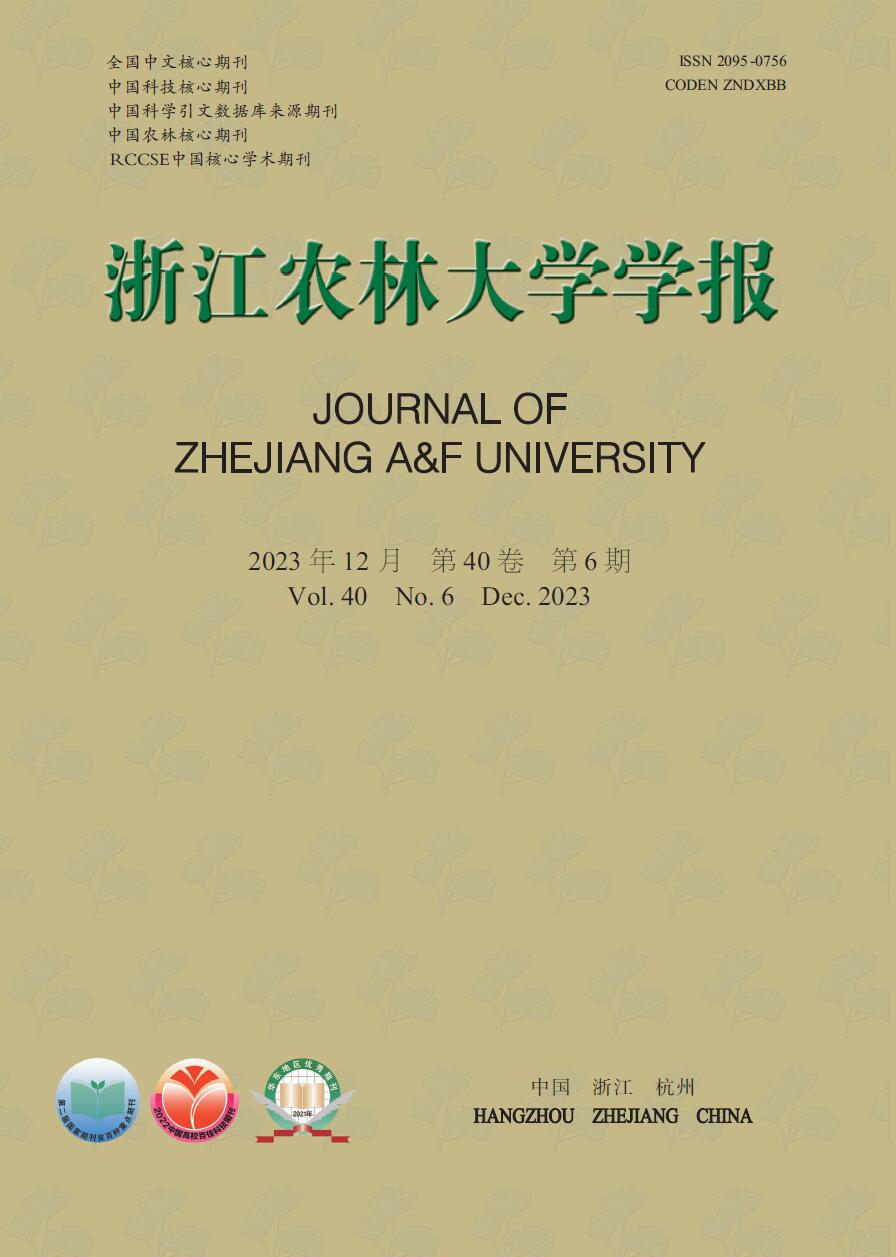


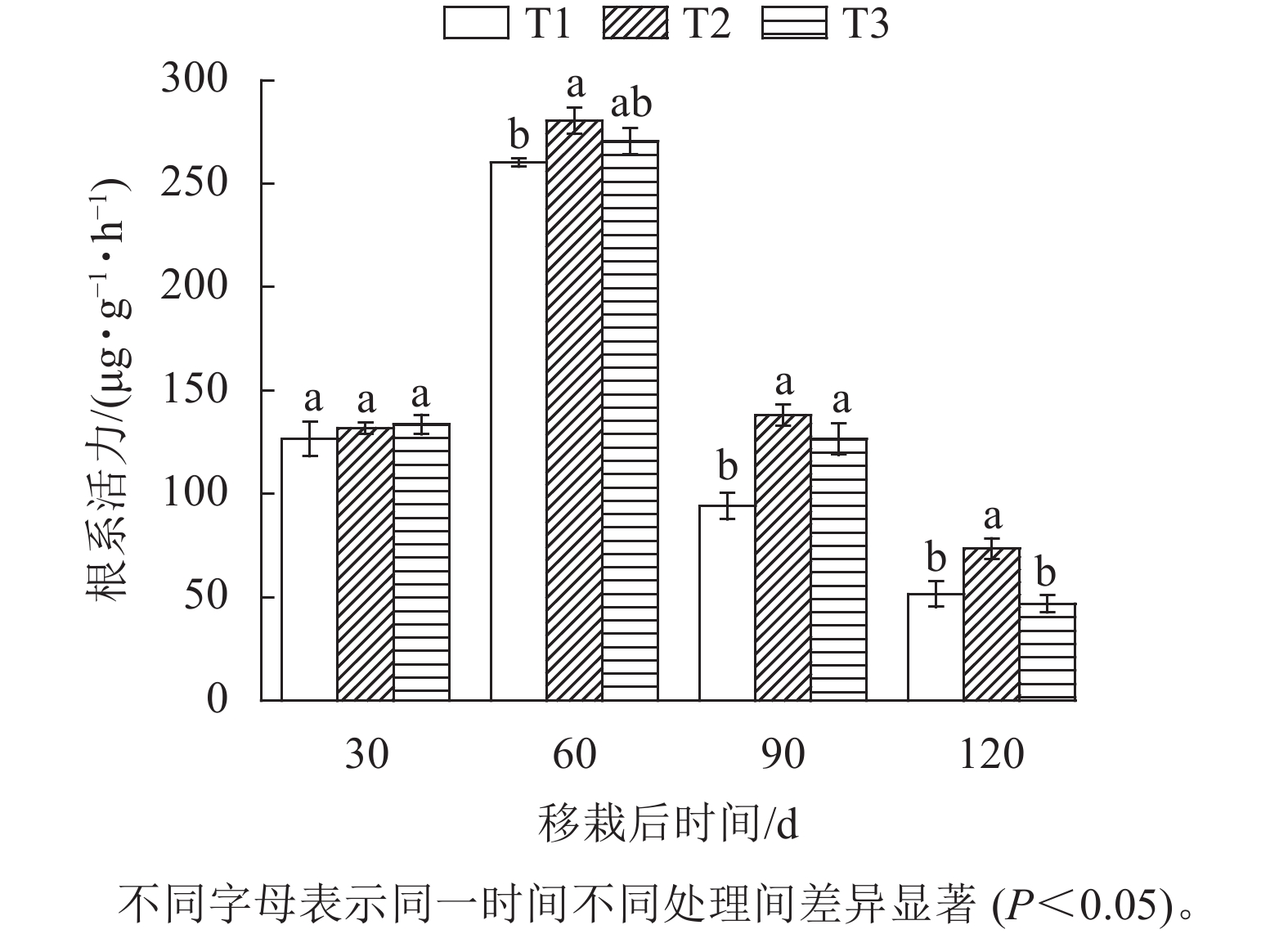


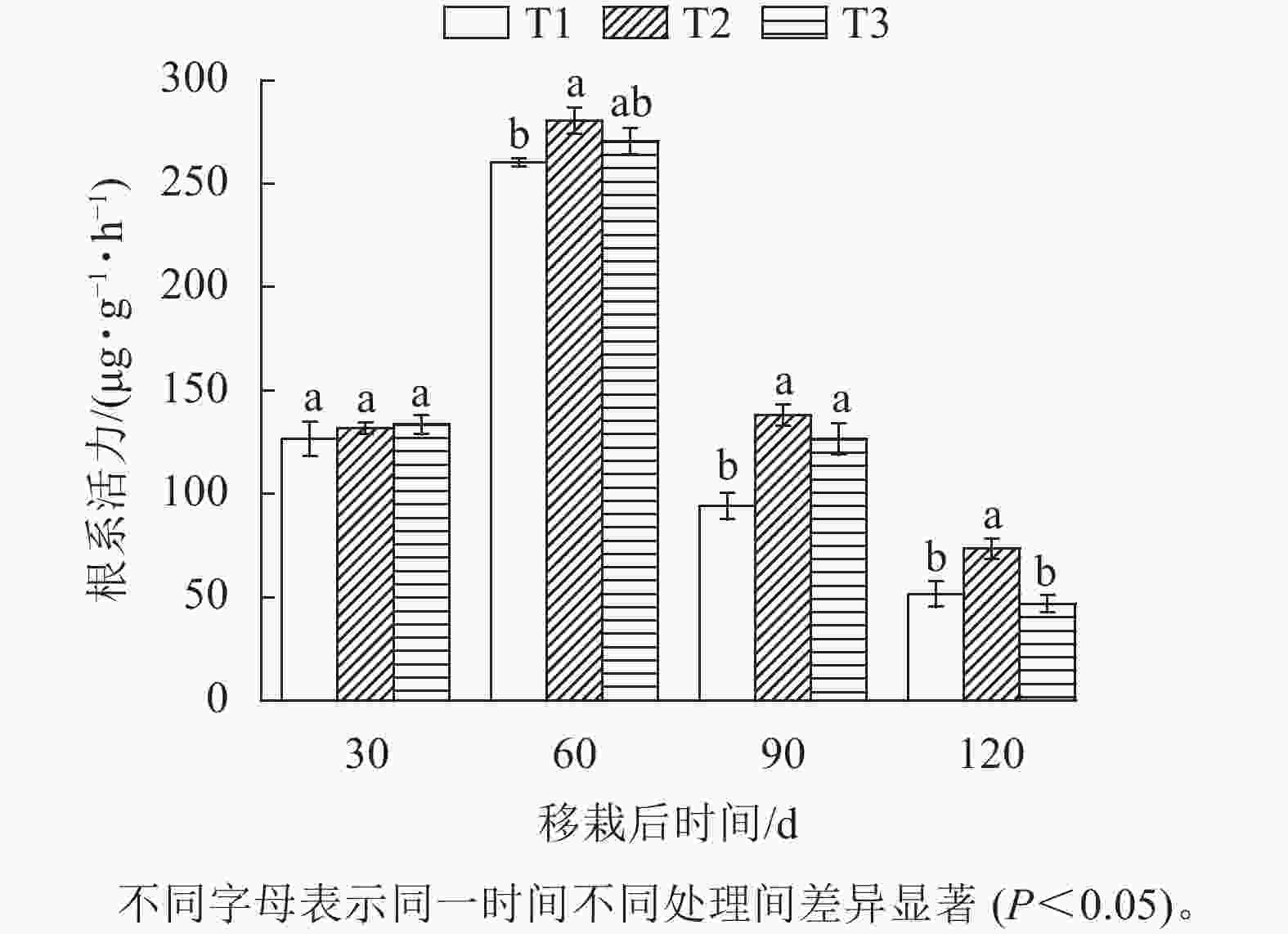
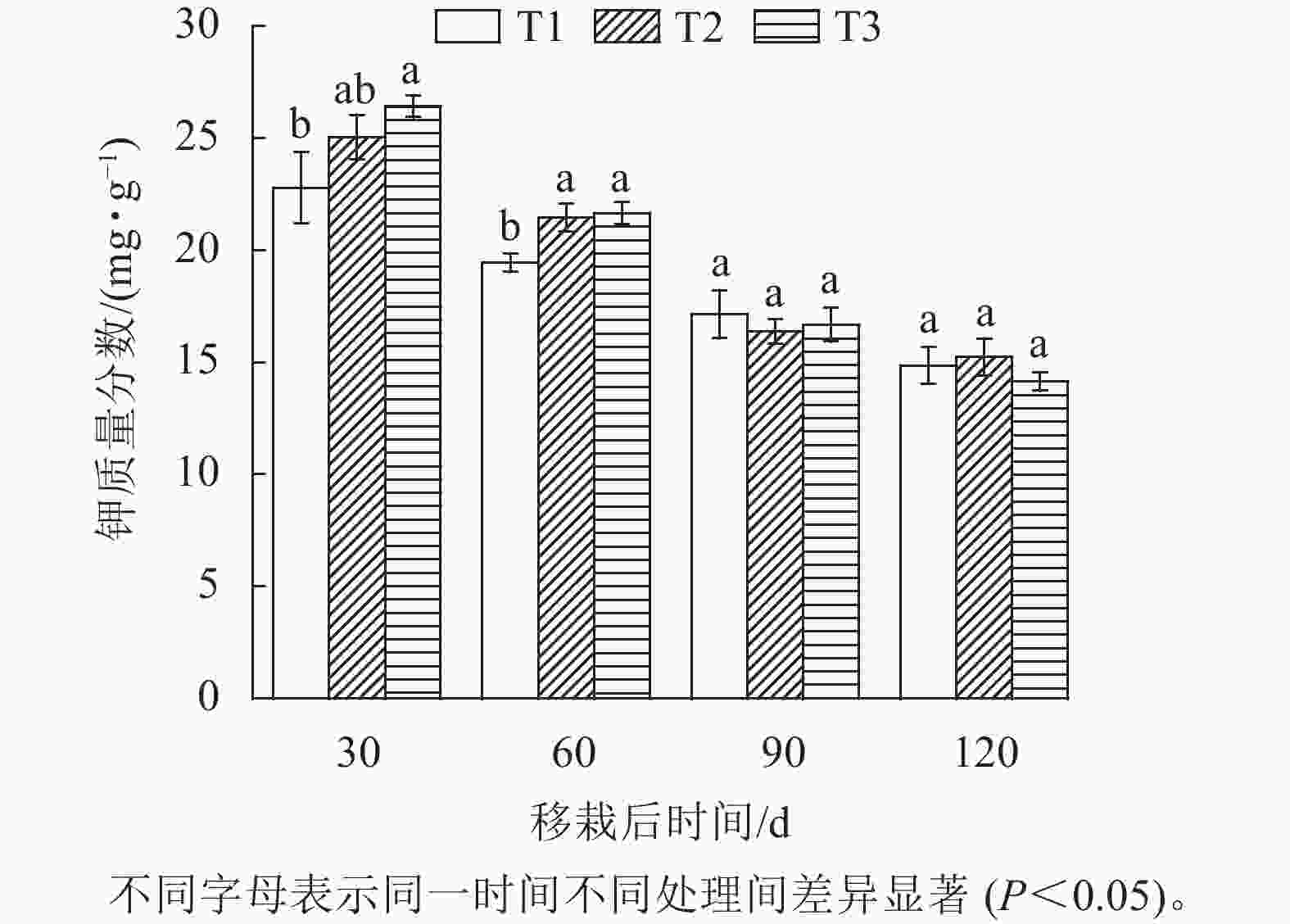
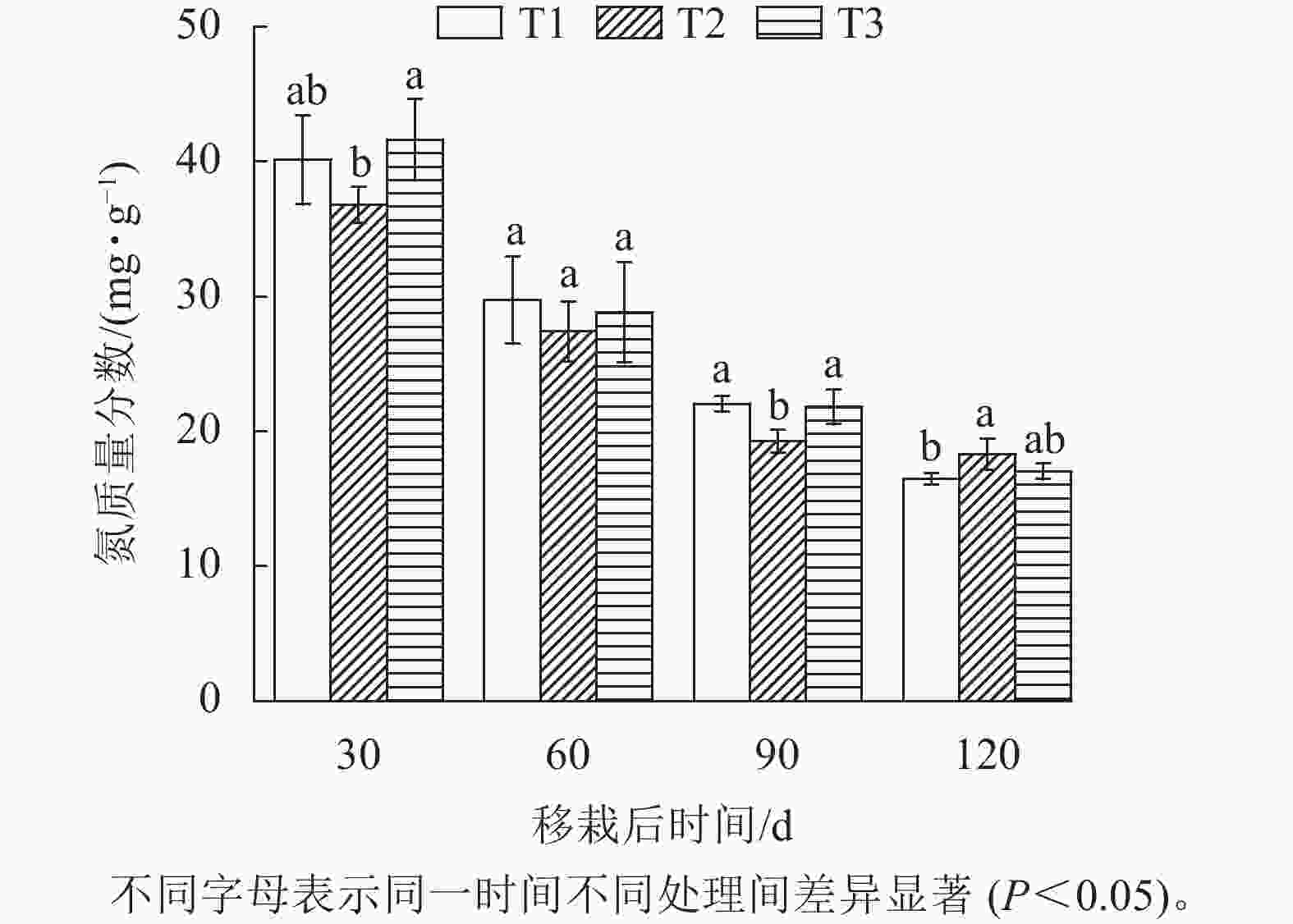
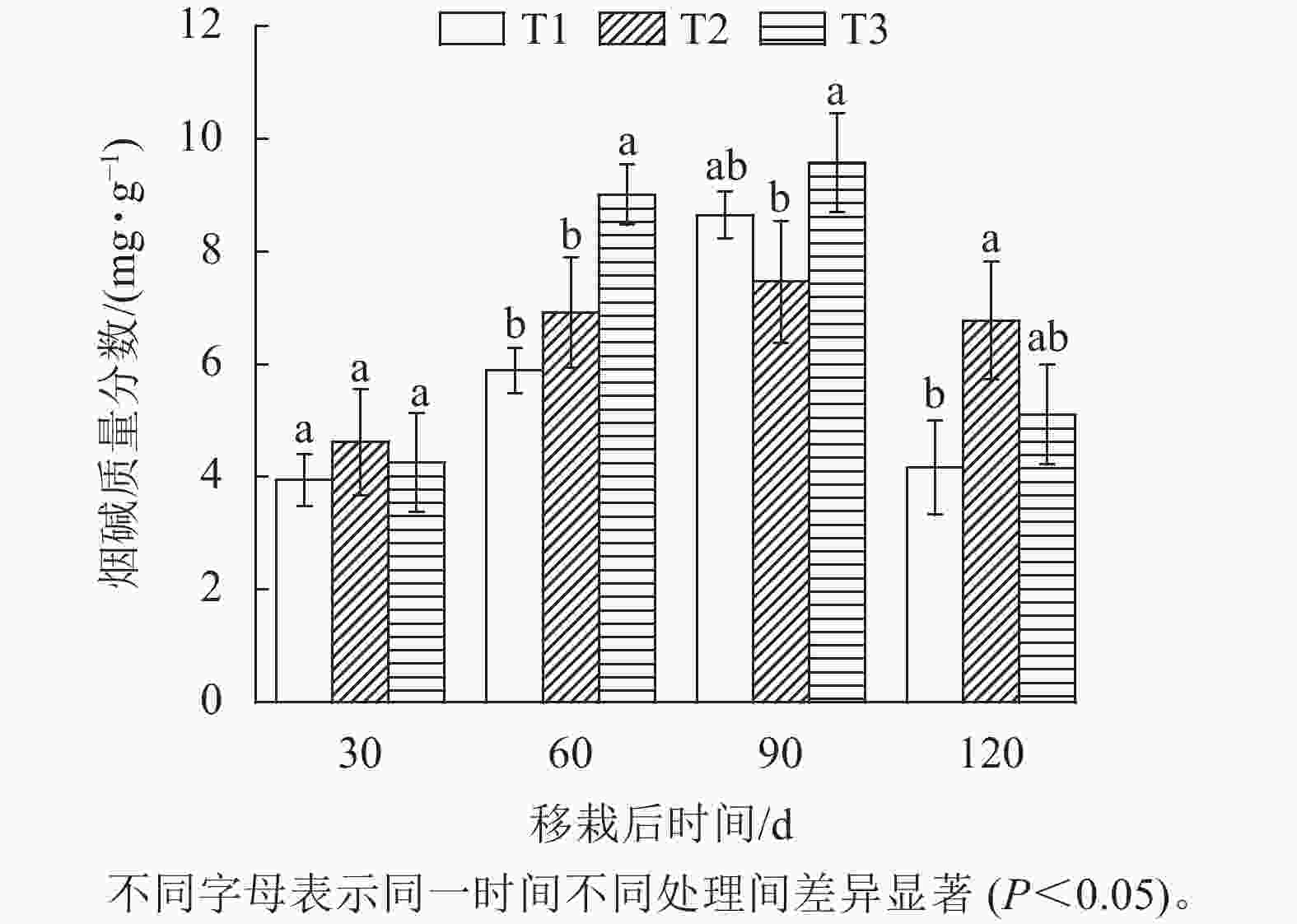
 DownLoad:
DownLoad:

